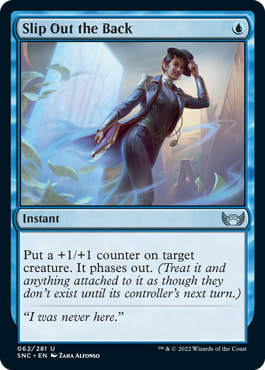In modern-day Magic, there are a handful of ways to protect a creature from dying to a removal spell. The old mantra, "Dies to Doom Blade" comes to mind. Since Wizards of the Coast doesn't put color limitations on removal spells these days, nearly every creature printed is vulnerable to spot removal in some shape or form.
To avoid such effects, you could cast a spell that grants your creature Hexproof until end of turn, with a spell like Shore Up. Such spells are great a combatting spot removal, but falls short if your opponent is playing a sweeper of sorts, such as Wrath of God. In cases like these, your best bet is to phase the creature out with a spell like Slip Out the Back.
Phasing a creature out effectively renders it nonexistent until its controller's next turn. Thus, a phased out creature can't be targeted or interacted it, and it can't be killed. As the flavor text implies, it's almost like the creature was never there.
It seems like phasing out is a good thing, but did you know that there was a keyword called Phasing that certain cards possessed, which acted as a drawback for the creature? Introduced in Mirage and effectively discontinued after Weatherlight, 16 cards have been printed with the Phasing ability.
The Rules for Phasing
Phasing is one of those keywords whose name sounds intuitive, but when you peel the onion back a couple layers, you find that the ability is much more complex. When you blink a creature, it disappears and then returns as a fresh creature--no more counters, no more auras, no more equipment attached. When you phase out, any auras, equipment or fortifications attached to that permanent phase out at the same time. When the permanent they are attached to phases back in, these auras, equipment, and fortifications also phase back in. The same goes for counters.
Another nuanced difference that used to create arguments amongst my friends and I is how ETB effects are handled. When a permanent is flickered, it triggers enter the battlefield effects. The same is not true for phasing. According to the comprehensive rules, "The phasing event doesn't actually cause a permanent to change zones or control, even though it's treated as though it's not on the battlefield and not under its controller's control while it's phased out." For this reason, all triggers affiliated with leaving or entering a zone won't happen due to phasing.
Before going down the rules rabbit hole, let's look at an example to bring this concept to life. How about a childhood staple of mine, Sandbar Crocodile from Mirage.
A 6/5 creature for five mana is pretty decent by today's standards, especially in Blue. That's a color that typically doesn't see many creatures with such aggressive stats, especially at common. To balance out the card's power, Wizards of the Coast gave Sandbar Crocodile Phasing. What that effectively means is, "This phases in or out before you untap during each of your untap steps. While it's phased out, it's treated as though it doesn't exist."
In the case of Sandbar Crocodile, this effectively boils down to: you have this creature every other turn. It can block on your opponent's next turn after you've casted Sandbar Crocodile, but you can't attack with it on your following turn because the creature phases out. The turn after, it'll phase back in and then you can attack. Half the time you control the creature like normal, half the time it doesn't exist.
While it doesn't exist, it can't be interacted with. While you'd prefer to be able to attack and block with a 6/5 creature all the time, giving the creature Phasing as a drawback allows WOTC to print the creature with a lower mana cost. Remember, this phasing occurs at the untap step--if an effect causes a player to skip their untap step (e.g., Stasis), the phasing event doesn't occur that turn.
Memorable Cards with Phasing
According to the MTG Fandom Wiki, 16 cards have been printed with Phasing, all from Mirage block (aside from Un-sets). As a result, it may come as no surprise that there aren't many iconic cards with the drawback ability. The most valuable card with Phasing is currently Taniwha, also from Mirage.
At 7/7 for just five mana, this has to be one of the most aggressively costed Blue creatures of all time. Having trample is a nice bonus, as the creature can't simply be chumped blocked when it attacks. Unfortunately, you'll only be able to attack with Taniwha every other turn because of its Phasing. What really limits this card's power, however, is its second line of text--the fact that it forces you to phase out all your lands as well!
The play pattern goes like this: you cast Taniwha and pass turn, then on your next turn you untap and Taniwha phases out, then on your next turn Taniwha phases back in and your lands phase out, on your next turn Taniwha phases back out and your lands phase in, etc. You read that correctly. You alternate between having Taniwha and lands every other turn. Yikes.
Another iconic card with Phasing is Teferi's Isle, also from Mirage.
Wizards rarely prints cards that tap for two mana these days, unless they require you to bounce a land. Teferi's Isle taps for two Blue mana, no land bounce required! The drawbacks are that it enters tapped and has phasing. Therefore, you can't actually use the land for mana for a couple turns after you play it, rendering the mana accelerant fairly ineffective for competitive play. That being said, a land with phasing was a novel idea and deserves some acknowledgement for being groundbreaking.
Another noteworthy card from Mirage is Shimmer, a card that doesn't have phasing itself but instead gives a basic land type phasing!
I play this enchantment in one of my Commander decks for the nostalgia. In today's world, players jam so many nonbasic lands into their decks that Shimmer's effect is relatively muted. Still, if you ever sit down against a mono-colored deck with many basics, you have an easy way to tip the balance heavily in your favor! I wish this card saw more play, but I understand it's not exactly the most fun thing to be casting.
Lastly, I want to talk about one of my personal favorite from childhood, even though the card itself is basically terrible: Warping Wurm.
What I loved about this card is the fact that you could pay four mana to stop Warping Wurm from phasing out. If you let it phase out, however, then it returns with a +1/+1 counter. Thus, it can grow itself, albeit incredibly slowly. I'm pretty sure I collected Wurms as a kid and this one was my favorite. In hindsight, the card is far too slow and inconsequential to matter.
Phase Out: Modern Day Phasing
On the Storm Scale, Phasing is a 9 according to Mark Rosewater, meaning he will never say never, but including Phasing in a Standard set again would require a minor miracle. I can see why--the ability is a bit cumbersome to keep track of, and is a significant drawback to a card. Yes, a phased-out creature dodged a board wipe such as Wrath of God, but only being around every other made the cards unattractive to play.
Then, years later, Wizards of the Coast introduced a spin on Phasing by bringing back the ability to phase something out as a means of protecting it. This was an ability that exited before, such as on Mist Dragon, but was left for dead for many years. Wizards found the utility to protecting permanents by phasing them out once, and gave us the ultimate such spell in Teferi's Protection.
For three mana, everything is protected. You can't be targeted by your opponent's stuff and your life total can't change! Your permanents are protected by phasing out--something that was a drawback when consistent and uncontrollable became a major asset when you could control when the phasing happens. Now if your opponents play a sweeper, you can temporarily remove all your cards from play via phasing, only to have them return to the play again on your next untap step.
Since its reintroduction, the concept of phasing cards out on command not only saw more print, but eventually became deciduous! That's why, after many years in hibernation, the concept of phasing once again became popular in mainstream Magic.
Now there are a few dozen cards with the ability to phase out on command or cause something else to phase out. These cards show up all over the place, including in recent sets - see Clever Concealment.
Wizards took the powerful, attractive part of phasing--the protection component--and turned it into a powerful, deciduous mechanic that can show up time and again!
Wrapping It Up
I'd like to take a moment to step back and pour one out for phasing. I'm sure not many players have even heard of Taniwha or Shimmer, let alone have desire to cast such cards.
While it didn't deliver on the gameplay experience that Wizards was hoping for, the phasing did inspire a deciduous, popular ability. Being able to phase something out as a protective measure is a useful, powerful effect worth having in your back pocket, especially in Commander. The resurgence of phasing out also helped WOTC clean up the text on some older cards as well. Consider the original printing of Oubliette in Arabian Nights as compared to its reprint that leverages the "phase out" terminology. The effect is much cleaner thanks to phasing.
It's great to see how an older, once-defunct ability can be repurposed to great success. This is one of the strengths of WOTC R&D, and I hope we see more updates and adjustments like this on other obsolete mechanics in the future!
































